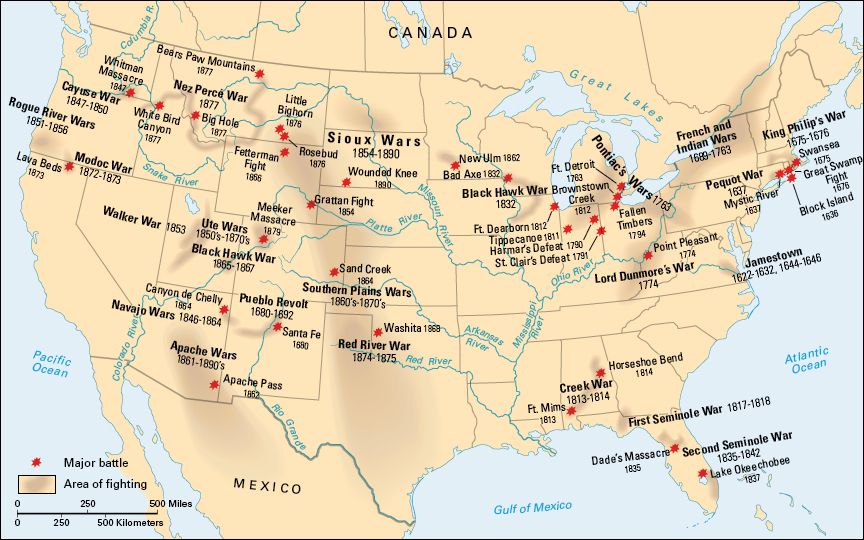Black Hawk War was a conflict in 1832 between United States forces and Native American Sauk and Fox people. The Native Americans were led by Black Hawk, a Sauk leader. The conflict was fought in northern Illinois and southern Wisconsin.
Background.
In 1804, some Sauk and Fox leaders signed a treaty that ceded to the United States their lands east of the Mississippi River. The treaty, however, left unclear exactly when the Native Americans had to leave these lands. Black Hawk refused to accept the treaty. He claimed that the chiefs had been given intoxicating liquors before they signed the documents.

Traditionally, the Sauk and Fox lived and grew crops in their villages east of the Mississippi River from spring to fall. In winter, they lived in small hunting bands on the prairies west of the river. In 1828, U.S. agents pressured the bands not to come back after the winter, but to start villages west of the Mississippi. Those who returned in 1829 and 1830 found settlers moving onto their land. By 1830, most of the Sauk and Fox had relocated to Iowa. Those who moved were led by Keokuk, a Sauk leader who favored cooperating with the United States. In 1831, the U.S. Regular Army and Illinois militia (citizens’ army) forced Black Hawk’s band onto the Iowa reservation.
The war.
On April 5, 1832, Black Hawk led a band eastward, back across the Mississippi into Illinois. The band included about 1,000 warriors, women, and children. Black Hawk, who had fought for the British during the War of 1812 (1812-1815), believed that British forces in Canada and other tribes would give him aid.
Black Hawk’s band moved northeast up the Rock River, hoping to join forces with the British and other tribes. But by mid-May 1832, Black Hawk had learned that the British and other tribes would not support him. With his supplies dwindling, Black Hawk decided to return to the west side of the Mississippi.
On May 14, Black Hawk sent emissaries (messengers) to request a truce. Under a white flag, they approached militia troops camped south of present-day Rockford, Illinois. However, the militia fired on the group, killing one of the emissaries. Black Hawk’s men then defeated the militia in a skirmish. Black Hawk abandoned his plan to return to the reservation and continued up the Rock River toward Wisconsin.
During the spring and summer months, hundreds of Regular Army soldiers and thousands of militia troops, mainly from Illinois, pursued Black Hawk. On July 21, a large force caught up to Black Hawk near present-day Madison, Wisconsin. Black Hawk’s warriors held off the army and militia troops. The Indians pushed west across southern Wisconsin toward the Mississippi River.
On August 1, Black Hawk’s band reached the Mississippi. Many of his followers had died of starvation or deserted on the way. As they prepared to cross the river, a U.S. military steamboat appeared. The steamboat ignored a white flag of truce and fired on the Sauk. The U.S. troops caught up to Black Hawk’s band the next day. Trapped between the steamboat and the troops, many Sauk were killed trying to cross the Mississippi. The Sioux, who were enemies of the Sauk, killed many of those who crossed the river into northeastern Iowa.
Aftermath.
During the course of the Black Hawk War, about 70 U.S. soldiers and settlers were killed. Historians estimate that between 400 and 600 Sauk were killed.
In late August 1832, Winnebago (now Ho-Chunk) people discovered Black Hawk and convinced him to surrender to the United States. Black Hawk was briefly imprisoned. On September 21, the Sauk and Fox signed a peace treaty that ceded millions of acres of land in Iowa to the United States. Black Hawk died on a reservation near Des Moines, Iowa, on Oct. 3, 1838.
A number of future leaders played a role in the Black Hawk War. Future U.S. President Zachary Taylor led troops against Black Hawk’s warriors. Future President Abraham Lincoln became a captain in the Illinois militia, though he never saw battle. Jefferson Davis, who served as president of the Confederacy during the American Civil War (1861-1865), delivered Black Hawk to a prison near St. Louis.
A separate conflict that took place between 1865 and 1872 is also called the Black Hawk War. In that conflict, a Ute chief named Black Hawk launched an uprising against Mormons in Utah. For more information, see Utah (Indian relations).
